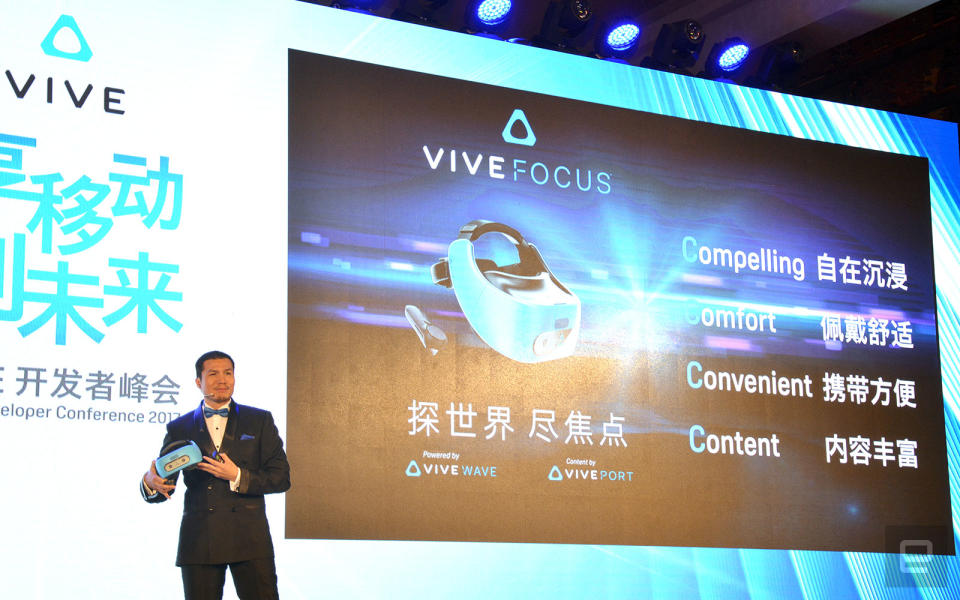HTC Vive Focus is a standalone VR headset with ‘world-scale’ tracking
No PC nor base stations required for this 6DoF VR device.
After a couple of teases earlier this year, HTC has finally unveiled its upcoming standalone VR headset at today's Vive Developer Conference in Beijing. Dubbed the Vive Focus, this all-in-one device features inside-out 6-degree-of-freedom (6DoF) "world-scale" tracking, meaning it doesn't require external base stations nor sensors, so you can get positional tracking anywhere at any time -- even on a train or plane, should you wish to. While at least a couple of Chinese manufacturers have announced standalone 6DoF VR headsets before, HTC claims that the Focus will be the first of such kind to actually hit the market.
"In the past, standalones have always kind of represented a mediocre balance, where you don't have much content and you can only do rotational, and it's not that much different than Cardboard except now you have one individual machine," HTC Vive's China President Alvin Wang Graylin told Engadget. "Now you can essentially do most of the things that you could do on a high-end machine on a standalone."
"Now you can essentially do most of the things that you could do on a high-end machine on a standalone."
We already knew that the Focus packs a Qualcomm Snapdragon 835 with instant on support, and now we're told that it also features a "high-resolution" AMOLED screen plus a rotational head strap that's similar to the Vive's Deluxe Audio Strap. Perhaps the only surprising bit of info is that the Focus comes with a 3DoF controller, though I was assured that it will still give "a very good experience" when paired with the 6DoF headset.

But that's not to say that developers can't add 6DoF hand input to the Focus. Also announced today is the Vive Wave VR open platform, which is basically Daydream for China with 12 hardware partners already signed up, including Quanta, Pimax, Nubia, iQIYI and more. With the Vive Wave SDK, vendors can integrate accessories -- be it a Leap Motion, gloves or even outside-in solutions for 6DoF input (and potentially eye-tracking solutions to ease up rendering resources).
So when developers port their Vive content to Vive Wave, they can choose to adopt 3DoF hand input or keep 6DoF by using additional accessories. One such example is a VR game called Spark of Light which, according to its developer, only took three hours to port the original Vive version to Vive Wave. HTC Vive's Vice President Raymond Pao added that existing Daydream and Samsung Gear VR content would take less than a week to port to Vive Wave. Developers who are already using Unity will enjoy the added benefit of the new one-click process to publish to Viveport, along with in-app payment support starting with China.

At the same time, the OpenVR-compatible SDK optimizes the content for medium-level hardware –- be it Focus-like standalone devices or even phone-based solutions (like HTC's very own Link) -- in order to keep the latency to below 20 ms. According to Graylin, China's standalone VR market's revenue share grew from 5 percent to a whopping 24 percent in Q3 alone, while mobile VR still has 50 percent revenue share in the same region, so he believes that developers around the world will want to take advantage of Vive Wave to tackle both markets. On the other side of the field, hardware manufacturers will finally be able to standardize their devices in order to boost VR experience across the industry.
Going back to the Focus, one potential use case that intrigued me the most is that it can be hooked up to other HTC headsets -- be it the Focus or even the original Vive -- for social interaction. According to Graylin, this can be applied to a classroom where the teacher is doing a demonstration, while the students are all equipped with a Focus each and can see each other in the same virtual space. Better yet, they can also share virtual objects. Other similar use cases include Second Life-like social platforms, or it can be something as simple as watching movies with friends in a virtual cinema -- not an entirely new concept but now you can do so pretty much anywhere you want.

While today marked the official unveiling of the Vive Focus, HTC is still mum on availability and pricing. Graylin only made it clear that there won't be a Daydream version of the Focus yet, as HTC is, ahem, "focusing on the Focus for China" for the remainder of this year. Meanwhile, on the other side of the pond, Facebook has already announced its very own Oculus Go standalone VR headset, which will be available for $199 early next year but offers just 3DoF. We'll have an update as soon as we hear back from HTC, and stay tuned for our upcoming hands-on later.



